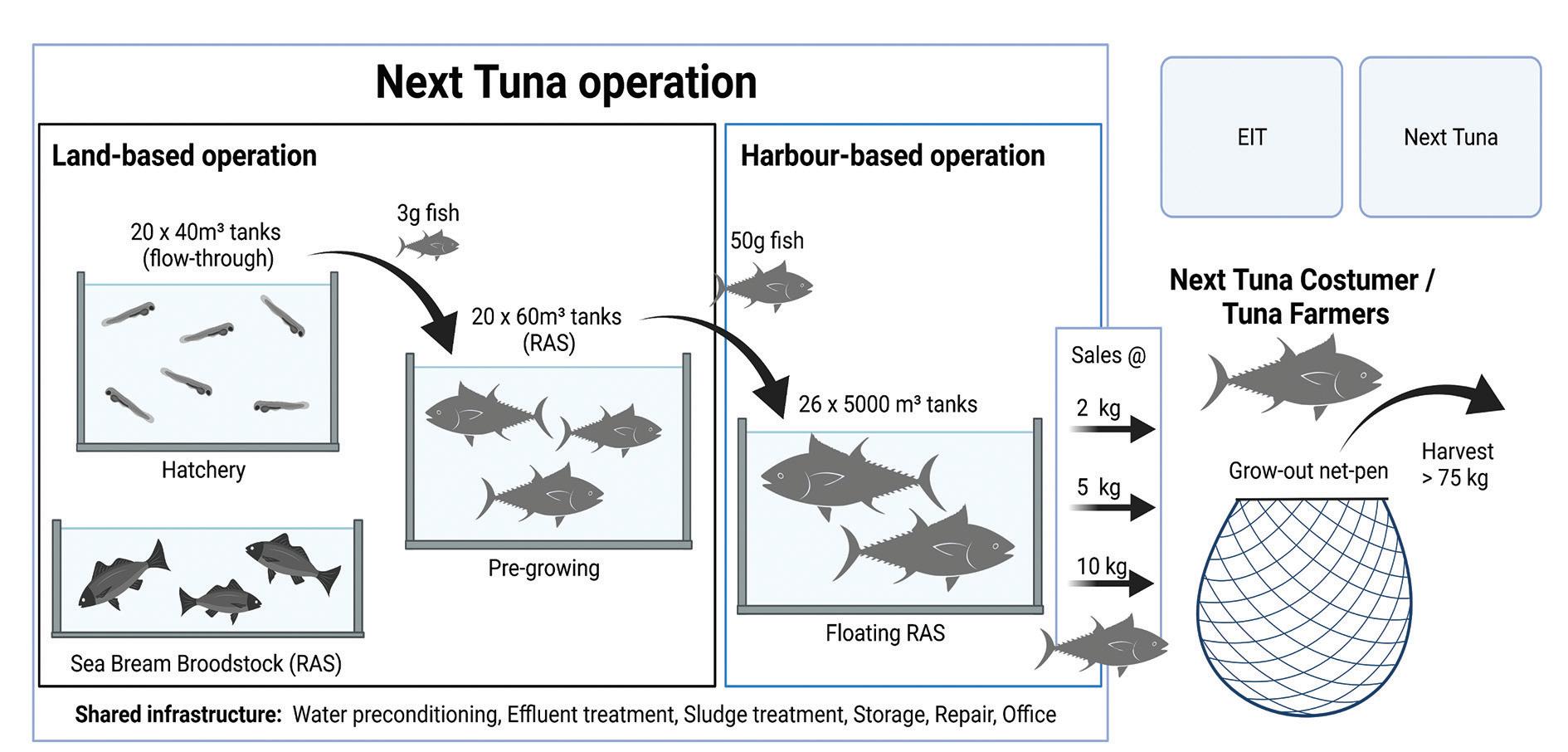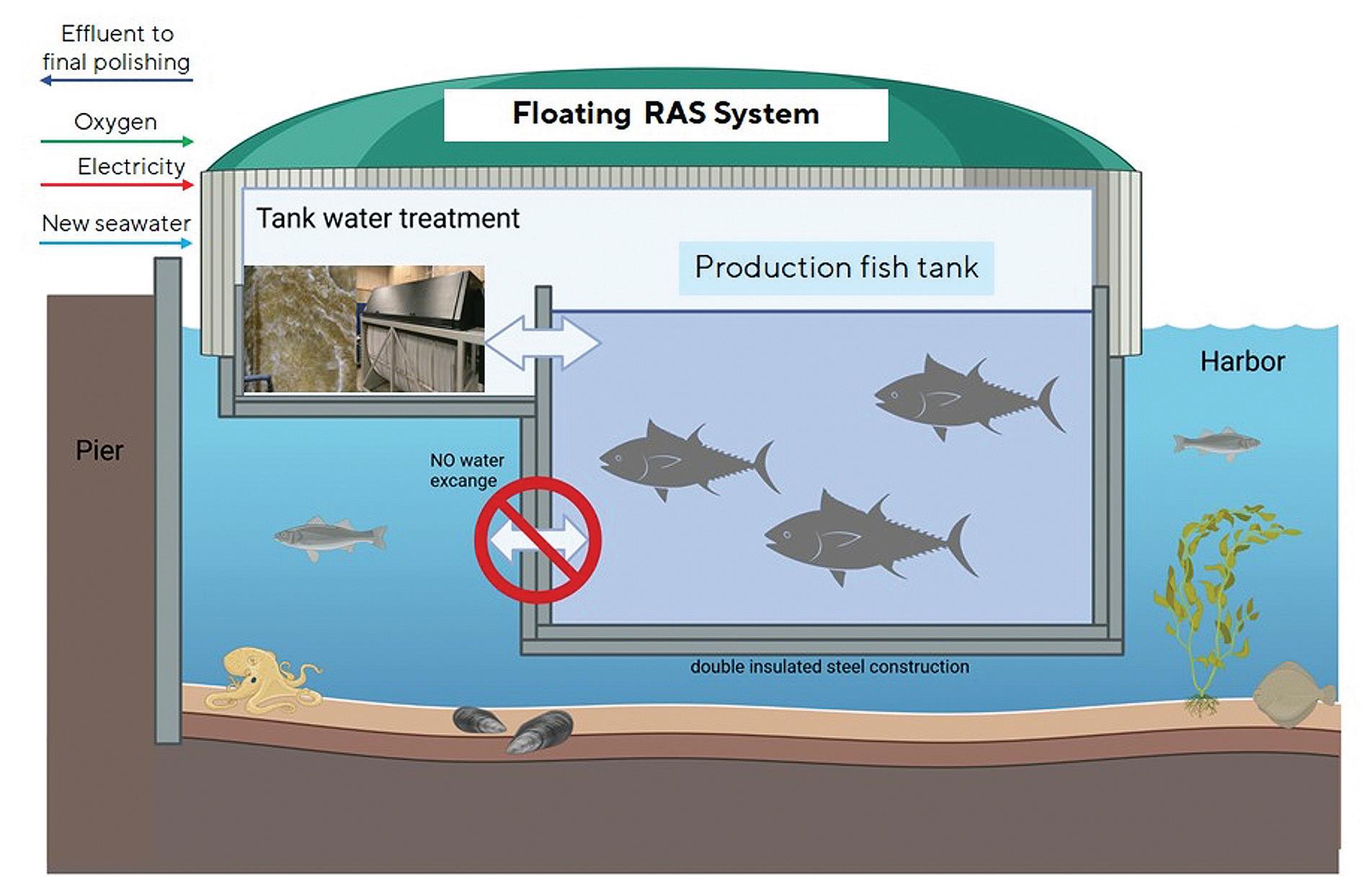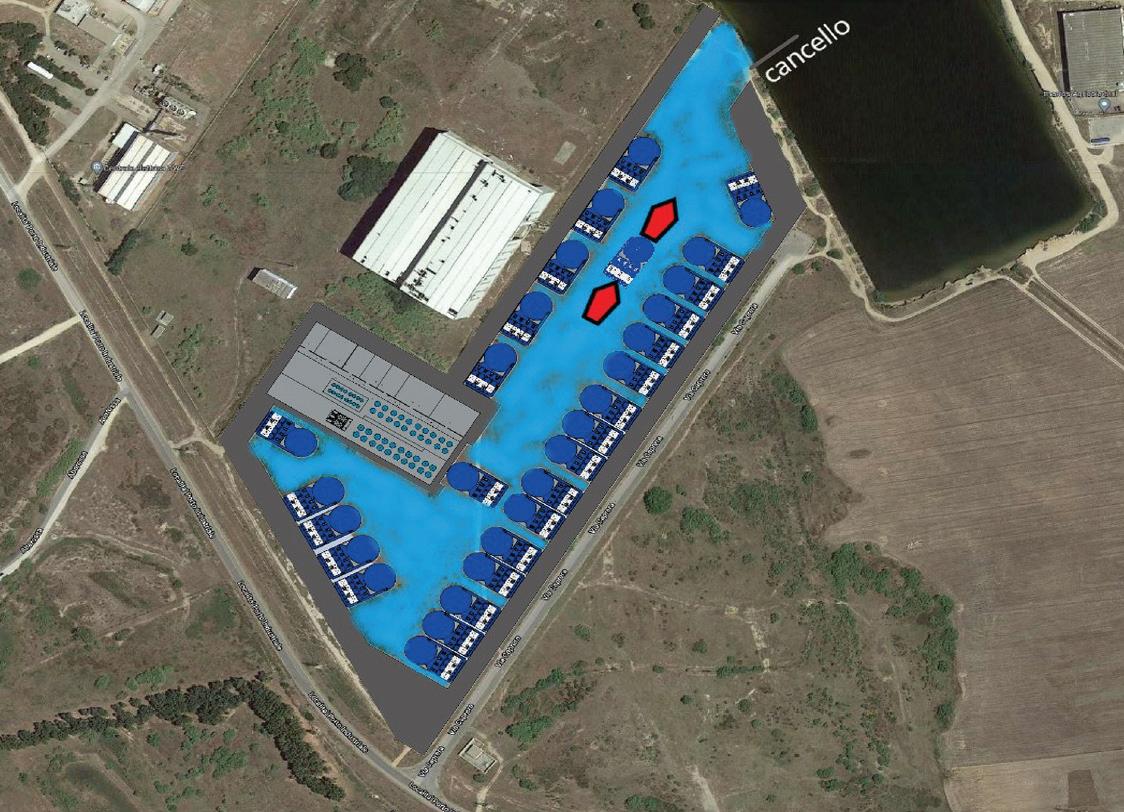
5 minute read
Closing the cycle in tuna aquaculture: Logistics are essential
Next Tuna GmbH (Next Tuna) is dedicated to the sustainable production and commercialization of Atlantic Bluefin Tuna (ABT) in the Mediterranean Sea (Med Sea). From our perspective, fish logistics is one of the key success factors for closing the ABT production cycle.
Tuna in general, and especially ABT, are very sensitive to handling. In the early life stages, the small fish are nearly impossible to touch without harm. At later stages, fish are simply too big to be handled in a meaningful way. Large parts of the planning and design work of the Next Tuna production facility concern internal and external fish logistics. The only established means of fish logistics in the existing ABT fattening industry is the fish transport of juvenile (Croatia) and adult (rest of the Med Sea) by transport net pens from the place of catching to the place of further fattening production.
Next Tuna decided to use the established net-pen transport as means of delivery from the juvenile production facility to Next Tuna customers. Thus, no changes to the existing tuna industry standards are needed, and Next Tuna juveniles can feed smoothly into the existing tuna value chain.
We described in the Hatchery Feed & Management Vol 9 Issue 4, the measures planned for the fish logistics inside the hatchery (Giebichenstein & Sindilariu, 2021). This article describes the fish logistics from the hatchery to the transport net-pens departing to Next Tuna customers.
Next Tuna: The production concept
The first Next Tuna project description (Giebichenstein & Sindilariu, 2021) was focused on the land-based operation of Next Tuna (Fig. 1). This contribution focuses on the harbor-based operation, where the 50 g fish received from the hatchery are grown to 2-10 kg juveniles ready to sell (Fig. 1).
Figure 1. Schematic set-up of Next Tuna production facility. Created with BioRender.com.
Figure 2. Schematic set-up of floating RAS system. Created with BioRender.com.

Next Tuna harbor-based operation
Next Tuna harbor-based operation consists of up to 26 floating RAS systems. The floating RAS system, designed by Next Tuna and its project partner, Seafarming Systems AS, is comparable to a 25 m diameter, 10 m depth net-pen. However, instead of a net that keeps the fish, the floating RAS has a fish tank made of insulated steel and the RAS treatment infrastructure is allocated on the same floating structure. The floating RAS systems have two operational modes: • Production mode: the system is connected to a harbor dock, or moored in a sheltered area and receives all essential supplies from land. • Delivery mode: the system is disconnected from land supplies, pulled out of the sheltered/harbor area into the open sea and joined with the delivery net-pen, for safe and stress-free fish transfer. During production mode, the floating RAS receives all supplies from land, including, electricity, oxygen, new (sea) water and delivers all residuals back to land for final effluent water treatment (Fig. 2).
The fish feed is supplied by net-pen feeders, which can be centrally loaded from the feed store in the Next Tuna harbor and connected to each floating RAS. This gives maximum flexibility, with no additional infrastructure for feed supply needed.
The RAS effluent streams are further treated on land. In a sludge thickening station, the particulate matter from the drum-filter backwash is separated from the liquid fraction. The particulate matter is further processed in a biogas facility, while the liquid fraction, is treated together with the system effluent in an IMTA approach (multitrophic integrated aquaculture) with macro/microalgae and mussels.
The floating RAS offers the advantages of a land-based RAS and adds the flexibility of a floating production platform while being in the delivery mode.
In delivery mode, the system is disconnected from all land supplies, but the RAS system is still in full operation. The electricity for the system is supplied from an emergency generator installed on each floating RAS. Oxygen is supplied from a bundle of oxygen bottles used during the transfer mode located on the platform of the floating RAS.
The delivery mode is used on one hand to receive fish from the hatchery with a crane delivery system (Fig. 3) described by Giebichenstein & Sindilariu (2021). The 60m3 tanks used in the hatchery can also be used for fish transfer. The tanks are lifted out of their place including fish and water, by a crane system and moved on top of the floating RAS. The tank (with fish) is then lowered into the water of the floating

Figure 3. Schematic loading of a hatchery tank into the floating RAS system by crane. Courtesy of AFRY. • Cost of construction: The floating RAS is easier to implement than a land-based system. No costly ground-breaking/digging is necessary. The only requirement is either harbor/dock space or sheltered areas with wave heights within design limits (which can be adapted to local requirements); • Modular production increase: The number of floating RAS can be increased as production volumes increase. It would actually be the first time in the industry that identical
RAS systems are operated across one production facility. This keeps the service and maintenance costs at a minimum.
RAS and the fish are gently flushed into their new environment (Fig. 3).
On the other hand, the delivery mode is used to pull the floating RAS out of Next Tuna harbor and join the system with a transport net-pen, to facilitate the delivery of juvenile ABT ready to sell (Fig. 4). The delivery mode, however, can only be operated in calm weather conditions, taking chosen design limits into account. Next to the flexibility/logistic advantages, the floating RAS offers additional beneficial features for an easy operation: • Access, service and maintenance: After the delivery of a fish batch, the floating RAS can be easily serviced inside and outside, as the system will rise out of the water as more water is pumped out of the system.
Thus, inside and outside maintenance or potential changes are easy to implement, as nearly all parts of the system become accessible;
Conclusion
The floating RAS concept is a key feature of the Next Tuna production facility. It serves fish production and facilitates critical fish logistics. It will allow Next Tuan to achieve its production goals of 1,200T of ABT juveniles in the size range of 2-10 kg. The system further enables Next Tuna to feed the ABT juveniles into the existing tuna fattening industry and use the well-established means of tuna transportation by net-pens. Figure 4. Depiction of Next Tuna harbor facility with one floating RAS in delivery mode, leaving the harbor pulled/pushed by two tug boats. In addition, the floating RAS offers critical advantages compared to a land-based RAS set-up, like simplified maintenance, real modularity of production and reduced cost of implementing the floating RAS compared to land-based RAS solutions.
More information: Jan Giebichenstein
Co-Founder Next Tuna E: jan@nexttuna.com
More information: Paul-Daniel Sindilariu
Co-Founder Next Tuna E: paul@nexttuna.com











